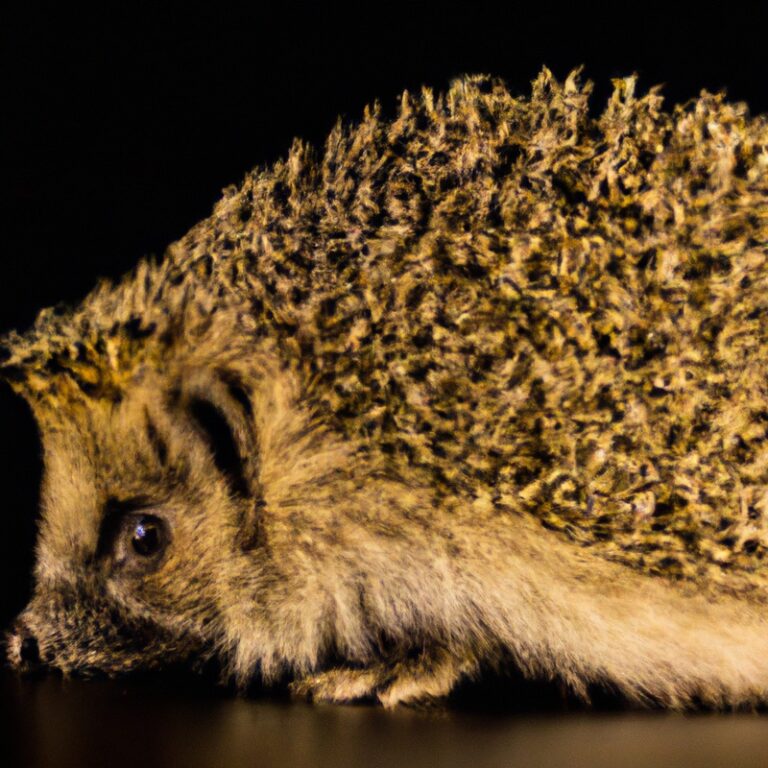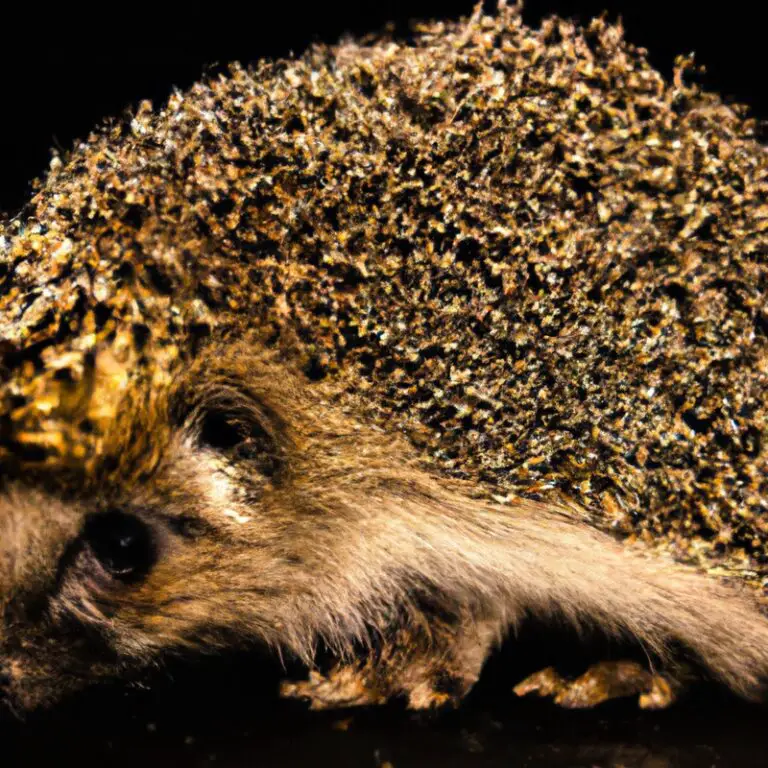How To Create a Hedgehog-Friendly Shelter In Your Garden?
Key Takeaways:
- Provide shelter with dense shrubs, piles of logs, or purpose-built hedgehog houses.
- Create hedgehog highways by cutting small holes in fences to allow them to move freely between gardens.
- Avoid using slug pellets and pesticides that can harm hedgehogs.
- Provide a shallow bowl of fresh water and leave out hedgehog-safe food, such as wet cat food or mealworms.
Looking to create a charming haven for hedgehogs in your garden? Well, you’re in the right place! In this article, we’ll show you how to build a hedgehog-friendly shelter that will not only provide a safe space for these prickly creatures to rest and hibernate but also contribute to their overall conservation.
We’ll delve into the fascinating world of hedgehog behavior, guide you in choosing the perfect location, and even provide step-by-step instructions for constructing your very own hedgehog haven.
So, let’s roll up our sleeves and get ready to welcome these adorable visitors into your garden!
| Materials needed | Pros | Cons |
| Wooden box or plastic storage container | – Provides a safe and secure shelter – Durable and weather-resistant – Easy to clean and maintain | – May require some construction skills – May need additional insulation in extreme weather conditions |
| Straw or hay | – Provides insulation and bedding – Comfortable for hedgehogs – Natural and biodegradable | – May attract other animals – Needs to be replaced regularly to maintain hygiene |
| Leaves or foliage | – Provides additional insulation – Mimics natural hedgehog habitat – Helps retain moisture | – May need to be replenished frequently as it decomposes |
| Entrance tunnel or pathway | – Creates a safe and hidden entrance – Prevents larger animals from entering | – Requires some digging or construction work |
| Water dish | – Provides a water source for hedgehogs | – Needs to be refilled regularly and kept clean |
Why Create a Hedgehog-Friendly Shelter?
Creating a hedgehog-friendly shelter in your garden is important for hedgehog conservation and providing a safe habitat for these adorable creatures.
Importance of Hedgehog Conservation
Hedgehog conservation is crucial because hedgehogs play a vital role in our ecosystem.
They help control insect populations, including harmful pests like slugs and snails.
Conserving hedgehogs also ensures the maintenance of a balanced food chain.
Furthermore, hedgehogs are indicators of a healthy environment, so their presence signifies the well-being of other wildlife species.
By protecting hedgehogs, we contribute to the overall biodiversity and sustainable future of our ecosystem.

Creating a Safe Habitat for Hedgehogs
Creating a safe habitat for hedgehogs is vital for their survival.
Here’s what you can do:
- Provide shelter: Create hedgehog houses or use log piles, dense shrubs, or compost heaps as hiding spots.
- Access to food and water: Leave out shallow dishes of fresh water and provide a hedgehog-sized hole in your garden fence for them to forage for insects.
- Avoid harmful substances: Use organic gardening methods and avoid slug pellets, pesticides, and herbicides that can harm hedgehogs and their food sources.
- Create escape routes: Ensure there are ramps or steps in ponds to help hedgehogs escape if they fall in.
- Maintain a safe environment: Check for hazards like netting, bonfires, or uncovered drains that could trap or injure hedgehogs.

Understanding Hedgehog Behavior
Hedgehog behavior and habits play an important role in their survival and well-being.
Hedgehog Habits and Habitat Requirements
Hedgehogs have certain habits and specific requirements when it comes to their habitat. Here’s what you need to know:
- Hedgehogs are nocturnal animals, meaning they are active during the night and sleep during the day.
- They are solitary creatures and prefer to live alone, unless it’s mating season.
- Hedgehogs need a safe and secure shelter to protect them from predators and extreme weather conditions.
- They like to build nests using leaves, grass, and other natural materials, so providing a pile of these in your garden can be beneficial.
- Hedgehogs need access to fresh water, so keeping a shallow dish of water in your garden is important.
- Creating a hedgehog-friendly garden involves providing plenty of vegetation and a variety of insects and invertebrates for them to feed on.
- Avoid using pesticides and chemicals in your garden, as these can be harmful to hedgehogs and their food sources.
By understanding hedgehog habits and providing an appropriate habitat, you can help these adorable creatures thrive in your garden.
Hedgehog Diet and Feeding Practices
Hedgehogs have specific dietary needs that are important to consider when feeding them.
A hedgehog’s diet mainly consists of insects and bugs, such as beetles, worms, and slugs.
They also enjoy eating fruits and vegetables, like apples and carrots.
However, it’s crucial to avoid feeding them foods high in sugar or salt, as this can be harmful to their health.
Fresh water should always be available for them to drink.
Remember, a well-balanced diet is key to keeping your hedgehog healthy and happy.
Choosing the Right Location for Your Hedgehog Shelter
To choose the right location for your hedgehog shelter, consider factors such as accessibility, safety, and proximity to food and water sources.
Additionally, an ideal hedgehog shelter location should offer protection from extreme weather conditions and natural predators.
Factors to Consider
Factors to consider when creating a hedgehog shelter in your garden include location, accessibility, and safety.
- Location: Choose a quiet, secluded spot that is away from busy areas. Hedgehogs prefer a peaceful environment.
- Accessibility: Ensure that the entrance to the shelter is easily accessible for hedgehogs, with a gap of at least 5 inches wide and 3 inches high.
- Safety: Avoid using chemicals or pesticides in the vicinity of the shelter, as these can be harmful to hedgehogs. Keep the area free from potential hazards such as sharp objects or deep water.
By considering these factors, you can create a safe and inviting habitat for hedgehogs in your garden.
Ideal Characteristics of a Hedgehog Shelter Location
An ideal location for a hedgehog shelter should provide safety, warmth, and accessibility. It should be away from heavy foot traffic, noise, and areas where pesticides are used.
The shelter should be situated in a quiet and secluded area, preferably under dense vegetation or a bush.
Ensure the entrance faces south to capture sunlight and warmth. Avoid damp or flood-prone areas.
Remember to monitor the shelter regularly to ensure it remains secure and suitable for your spiky visitors.
Designing and Building the Hedgehog Shelter
To create a hedgehog-friendly shelter in your garden, you will need to design and build the shelter using suitable materials and tools.
Choosing the Shelter Type
When choosing a shelter type for hedgehogs in your garden, there are a few options to consider.
One popular choice is a hedgehog house, which provides a safe and cozy place for them to rest and hibernate.
Another option is a pile of leaves or branches, which can mimic the natural nesting areas that hedgehogs prefer.
You could also create a hedgehog-friendly area by leaving dense, wild areas of your garden undisturbed.
Whichever option you choose, make sure it’s located in a quiet and sheltered spot, away from any potential dangers.
Materials and Tools Needed
To create a hedgehog-friendly shelter in your garden, you’ll need a few materials and tools. Here’s what you’ll need:
- A sturdy wooden box or crate to serve as the shelter. Make sure it has a small entrance and is big enough for a hedgehog to fit comfortably.
- A waterproof cover to protect the shelter from rain and other elements.
- A soft bedding material like straw or leaves for the hedgehog to nestle in.
- A heavy object like a brick to secure the cover and prevent it from blowing away.
- Some natural camouflage materials like fallen leaves or twigs to blend the shelter into its surroundings.
That’s about it! With these materials and tools, you’ll be well on your way to creating a cozy and safe home for hedgehogs in your garden.
Step-by-Step Construction Guide
Step-by-Step Construction Guide:
- Find a suitable location in your garden that is quiet, secluded, and away from potential dangers like roads or predators.
- Dig a hole that is at least 30cm deep and wide enough to accommodate a hedgehog comfortably.
- Line the bottom and sides of the hole with sturdy materials such as bricks or stones to create a solid base and prevent soil erosion.
- Create a roof by placing a wooden board or sheet of metal over the hole, leaving a small entrance for the hedgehog.
- Cover the shelter with leaves, twigs, and other natural materials to provide insulation and camouflage.
- Ensure there is enough ventilation by leaving small gaps between the materials used for the shelter.
- Add a bedding material, such as dry grass or leaves, inside the hedgehog shelter to provide warmth and comfort.
- Maintain the shelter by regularly checking for damage or debris and replacing any worn or broken parts.
- Avoid using pesticides or chemicals in your garden, as these can be harmful to hedgehogs and their habitat.
- Finally, create a hedgehog-friendly environment by providing food and water sources, along with cover and shelter.
Adding Essential Features to the Hedgehog Shelter
To create a hedgehog-friendly shelter in your garden, make sure to focus on three essential features: ventilation and drainage, nesting materials, and easy access for hedgehogs.
Providing Ventilation and Drainage
When creating a hedgehog shelter in your garden, it’s important to provide proper ventilation and drainage. This will help ensure a comfortable and safe environment for the hedgehogs.
To achieve good ventilation, you can add small gaps or holes in the shelter.
This will allow air to circulate and prevent the shelter from becoming stuffy. Additionally, it’s essential to incorporate drainage holes or a raised floor to prevent water from pooling inside the shelter during rainy weather.
Good ventilation and drainage are key to creating a welcoming home for hedgehogs.
Incorporating Nesting Materials
To create a hedgehog-friendly shelter, it’s important to incorporate nesting materials. Hedgehogs like to make cozy nests for themselves, so providing materials like leaves, grass, and straw can give them a comfortable place to rest.
You can also add some fallen branches or twigs to give the nest structure.
Make sure to choose materials that are dry and clean, and avoid using any chemicals or pesticides. By providing nesting materials, you’re giving hedgehogs a safe and warm space to call home.
Ensuring Easy Access for Hedgehogs
To ensure easy access for hedgehogs in your garden, there are a few simple steps you can take.
- Create hedgehog-sized openings in your fence or hedge, measuring around 13 x 13 cm (5 x 5 inches. This will allow hedgehogs to freely roam between gardens, expanding their territory.
- Avoid using metal mesh or wire netting on the ground, as it can harm or trap hedgehogs. Instead, opt for solid fencing or use a 10 cm (4-inch diameter plastic pipe to create a safe passage.
- Remove any obstacles in your garden that may hinder hedgehog movement, such as low fences, steps, or deep ponds. Hedgehogs prefer flat, open spaces to navigate easily.
- Avoid using pesticides or chemicals in your garden, as they can be toxic to hedgehogs and harm their food sources, such as insects and slugs.
By implementing these measures, you can provide hedgehogs with a safe and accessible environment to thrive in your garden.
Maintaining and Monitoring the Hedgehog Shelter
Regularly clean and sanitize the hedgehog shelter to ensure a healthy environment.
Monitor hedgehog activity to assess the effectiveness of the shelter and identify any issues that may arise.
Regular Cleaning and Sanitization
Regular cleaning and sanitization of the hedgehog shelter is essential for ensuring the health and well-being of the hedgehogs.
Here are some key points to keep in mind:
- Remove any food scraps or waste from the shelter on a regular basis. This will help prevent the spread of diseases and keep the shelter hygienic.
- Clean the shelter with a mild bleach solution or a hedgehog-friendly disinfectant. This will help kill any bacteria or parasites that may be present.
- Ensure that the bedding in the shelter is changed regularly. This will keep the shelter fresh and clean for the hedgehogs.
- Regularly inspect the shelter for any signs of damage or wear. Repair or replace parts as needed to maintain a safe and secure environment.
Remember, regular cleaning and sanitization will help promote the health and well-being of the hedgehogs and create a safe and comfortable shelter for them.
Monitoring Hedgehog Activity
Monitoring hedgehog activity is important to ensure the well-being of these adorable creatures in your garden.
Here are some simple ways you can keep track:
- Set up a trail camera: Place a motion-activated camera near the hedgehog shelter to capture their nighttime movements. This will provide valuable insights into their behavior.
- Look for footprints: Check for hedgehog footprints in your garden, particularly near feeding areas or shelter entrances. Footprints can indicate their presence and give you an idea of their daily routines.
- Observe feeding patterns: Monitor the hedgehog’s food bowl to see how much they eat each night. Uneaten food can indicate a potential issue, while consistent feeding patterns show a healthy hedgehog.
- Create a journal: Keep a log of hedgehog sightings, activity levels, and any significant observations. This will help you spot trends or changes in behavior over time.
By actively monitoring hedgehog activity, you can contribute to their welfare and gain a deeper understanding of their habits and needs.
Troubleshooting Common Issues
Having issues with your hedgehog shelter? Here are a few common problems and their solutions.
- Feeding troubles: If the food you leave out is constantly being taken by other animals, try using a covered dish or feeding station to protect it.
- Predators: To deter predators, make sure your shelter has a secure entrance and is placed in a location that is not easily accessible to larger animals.
- Poor drainage: If the shelter is getting too wet, ensure it has adequate drainage by adding gravel or creating a small slope.
- Temperature control: Insulate the shelter with materials like straw or leaves to help regulate the temperature inside.
- Lack of interest: If hedgehogs are not using the shelter, try placing some of their preferred food nearby to attract them.
Remember, each hedgehog shelter may have unique challenges, but with a little troubleshooting, you can create an ideal habitat for these adorable creatures!
Creating a Hedgehog-Friendly Garden Environment
To create a hedgehog-friendly garden environment, focus on planting native shrubs and hedges and leaving areas of wild growth. Additionally, reduce the use of pesticides and chemicals in your garden.
Planting Native Shrubs and Hedges
Planting native shrubs and hedges in your garden is an excellent way to create a hedgehog-friendly environment. Native plants provide natural food sources and shelter for hedgehogs, as they attract insects and small invertebrates that hedgehogs love to eat.
Some popular native shrubs and hedges include hawthorn, blackthorn, and hazel.
These plants also create a natural barrier that helps keep hedgehogs safe from predators. Additionally, native shrubs and hedges require less maintenance and are better adapted to your local climate.
Leaving Areas of Wild Growth
One simple way to create a hedgehog-friendly environment in your garden is by leaving areas of wild growth. This means allowing parts of your garden to grow naturally, with long grass, fallen leaves, and a variety of plants.
These areas provide shelter and food for hedgehogs, as well as space for them to roam and forage.
You can enhance the wildness by avoiding excessive pruning and using organic gardening practices to avoid harmful chemicals. So, let some parts of your garden go wild and watch as hedgehogs find a welcoming home.
Reducing the Use of Pesticides and Chemicals
Reducing the use of pesticides and chemicals is important for creating a hedgehog-friendly garden. Instead of relying on these harmful substances, opt for natural alternatives such as companion planting, like marigolds to deter pests, or physical barriers like netting.
Regularly inspect and clean your plants to prevent pest infestations.
Encouraging natural predators like birds and frogs can also help control pests naturally. By adopting these eco-friendly practices, you can ensure a safe and welcoming environment for hedgehogs in your garden.
Encouraging Hedgehog Visitors
To attract hedgehog visitors to your garden, provide a welcoming environment and address potential hazards.
Providing Food and Water
To provide food and water for hedgehogs, you can create a small feeding station in your garden. You can use a shallow bowl or a specially designed hedgehog feeding station.
Fill it with cat or dog food (not fish-based) and a shallow dish of fresh water.
Make sure to place the feeding station in a quiet area away from potential predators. This will give the hedgehogs a safe place to eat and drink without disturbance.
Keep the food and water topped up regularly to ensure a steady supply for our spikey friends.
Avoiding Potential Hazards
To ensure the safety of hedgehogs in your garden, it’s important to avoid potential hazards. Here are some tips to keep in mind:
- Secure your garden: Make sure your garden is fully enclosed to prevent hedgehogs from wandering into dangerous areas like roads.
- Watch out for chemicals: Avoid using pesticides and slug pellets in your garden as they can be harmful to hedgehogs and other wildlife.
- Check for hazards: Regularly inspect your garden for any potential hazards like uncovered drains, deep holes, or sharp objects that could harm hedgehogs.
- Mind your pets: Keep an eye on your pets, especially cats and dogs, when they are in the garden to avoid any conflict with hedgehogs.
- Be cautious with water features: If you have a pond or any other water feature, create an easy escape route for hedgehogs to prevent them from drowning.
By taking these simple precautions, you can create a safe and inviting environment for hedgehogs in your garden.
Promoting Connectivity with Hedgehog Highways
To promote connectivity with hedgehog highways in your garden, you can create small holes in fences and walls to allow hedgehogs to roam freely. Ensure these holes are around 13 x 13 cm in size.
Additionally, remove any barriers like log piles or locking gates that may obstruct their movement.
Planting hedges or using dense vegetation can also create natural corridors for hedgehogs to navigate between gardens. Providing this connectivity will help hedgehogs find food, mates, and suitable habitats, contributing to their overall well-being.
Frequently Asked Questions (FAQs)
Can I keep a hedgehog in my garden as a pet?
Sure! Here’s a straightforward and concise answer to your question: Yes, you can keep a hedgehog in your garden as a pet.
Hedgehogs can thrive in a well-maintained garden that provides them with a suitable habitat.
Make sure to create a hedgehog-friendly shelter, such as a wooden box with a small entrance and cozy bedding.
Additionally, ensure your garden is safe by removing any hazards like chemicals or sharp objects.
Regularly provide food and fresh water for your hedgehog, and avoid using pesticides that could harm them.
How long does it take for hedgehogs to utilize the shelter?
Hedgehogs can start utilizing a shelter in your garden soon after it is made available to them. However, the exact timeframe can vary depending on factors such as the hedgehog population in your area and the availability of alternative shelter options.
It’s best to ensure that the shelter is well-designed and located in a quiet and safe area.
Providing food and water nearby can also attract hedgehogs to the shelter more quickly. Patience is key, as it might take a few days or even weeks for hedgehogs to fully utilize the shelter.
What should I do if I find an injured hedgehog in my garden?
If you find an injured hedgehog in your garden, the first thing you should do is keep calm and avoid touching it directly.
Put on gloves and gently place the hedgehog in a box or pet carrier with a towel or newspaper for bedding.
Offer it some shallow water and wet cat food.
Contact your local wildlife rescue or hedgehog rescue center for further advice and assistance.
It’s important to get professional help as soon as possible to ensure the hedgehog receives the care it needs.
Will creating a hedgehog-friendly shelter attract other wildlife too?
Creating a hedgehog-friendly shelter in your garden can indeed attract other wildlife too. Hedgehogs provide a safe and appealing habitat, and other animals may be drawn to the resources and shelter it offers.
Species like birds, insects, and small mammals might be enticed by the presence of a hedgehog shelter.
So, besides helping hedgehogs, you may witness an increase in biodiversity in your garden.
Final Verdict
Creating a hedgehog-friendly shelter in your garden is not only important for the conservation of these delightful creatures but also brings numerous benefits to your garden ecosystem.
By understanding hedgehog behavior, choosing the right location, designing and building the shelter, and incorporating essential features, you can provide a safe and comfortable habitat for hedgehogs.
Regular maintenance and monitoring are crucial to ensure the shelter remains suitable, and creating a hedgehog-friendly garden environment further enhances their habitat.
By welcoming hedgehogs into your garden, you contribute to their well-being and help maintain a healthy and balanced ecosystem.








